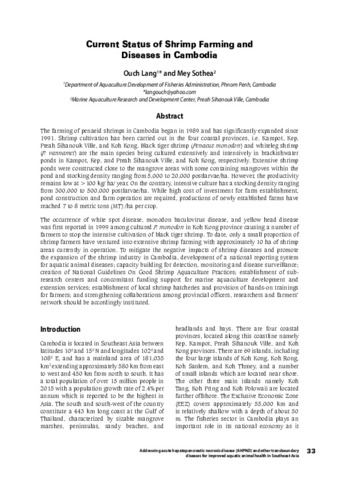| dc.contributor.author | Pakingking, Rolando V., Jr. | |
| dc.contributor.author | Lacierda, Erlinda | |
| dc.contributor.author | Torres, James L. | |
| dc.contributor.editor | Lavilla-Pitogo, Celia R. | |
| dc.contributor.editor | Cruz-Lacierda, Erlinda R. | |
| dc.date.accessioned | 2011-06-22T09:36:06Z | |
| dc.date.available | 2011-06-22T09:36:06Z | |
| dc.date.issued | 2002 | |
| dc.identifier.citation | Pakingking, R. V., Jr., Cruz-Lacierda, E. R., & Torres, J. L. (2002). Studies on the efficacy of Sarafin® (sarafloxacin hydrochloride) on vibrios associated with vibriosis in black tiger shrimp (Penaeus monodon). In C. R. Lavilla-Pitogo & E. R. Cruz-Lacierda (Eds.), Diseases in Asian aquaculture IV: Proceedings of the Fourth Symposium on Diseases in Asian Aquaculture, 22-26 November 1999, Cebu City, Philippines (pp. 125-134). Fish Health Section, Asian Fisheries Society. | en |
| dc.identifier.uri | http://hdl.handle.net/10862/501 | |
| dc.description.abstract | In vitro activity of Sarafin® (sarafloxacin hydrochloride) was determined against 7 luminous Vibrio harveyi isolates and 3 non-luminous Vibrio species (V. parahaemolyticus, V. alginolyticus and Vibrio species) isolated from diseased shrimp (Penaeus monodon) and rearing water, a strain of V. anguillarum from diseased marine fish, 1 strain each of V. alginolyticus, V. vulnificus, and V. mimicus from diseased grouper (Epinephelus coioides), and V. alginolyticus from diseased seabass (Lates calcarifer). Bacterial susceptibility was expressed as minimum inhibitory concentration (MIC) and minimum bactericidal concentration (MBC). The MIC and MBC values obtained for all V. harveyi isolates ranged from <0.3 to 1.25 µg/ml. For the non-luminous Vibrio species, MIC and MBC values ranged from <0.08 to 1.25 µg/ml. In vivo tolerance levels (24 h static bioassay) of larval and postlarval stages of P. monodon for Sarafin® were <10 µg/ml for nauplii, mysis, and postlarvae and ≤1 µg/ml for zoeae. Morphological deformities in the carapace, rostrum, and setae were noted among larvae exposed to >50 µg/ml Sarafin®. These results indicate that Sarafin® is a potential candidate as a chemotherapeutic agent against luminous vibriosis in P. monodon. | en |
| dc.language.iso | en | en |
| dc.publisher | Fish Health Section, Asian Fisheries Society | en |
| dc.subject | Crustacea | en |
| dc.subject | bio-assays | en |
| dc.subject | Philippines | en |
| dc.subject | prawns and shrimps | en |
| dc.subject | Penaeus monodon | en |
| dc.subject | Vibrio anguillarum | en |
| dc.subject | Vibrio parahaemolyticus | en |
| dc.subject | Vibrio vulnificus | en |
| dc.subject.lcc | VF SP 306 | |
| dc.title | Studies on the efficacy of Sarafin® (sarafloxacin hydrochloride) on vibrios associated with vibriosis in black tiger shrimp (Penaeus monodon) | en |
| dc.type | Conference paper | en |
| dc.citation.spage | 125 | |
| dc.citation.epage | 134 | |
| dc.subject.asfa | shrimp culture | en |
| dc.subject.asfa | bacterial diseases | en |
| dc.subject.asfa | disease control | en |
| dc.subject.asfa | toxicity tolerance | en |
| dc.subject.asfa | bactericides | en |
| dc.subject.asfa | Bacteria | en |
| dc.citation.conferenceTitle | Diseases in Asian Aquaculture IV. Proceedings of the Fourth Symposium on Diseases in Asian Aquaculture, 22-26 November 1999, Cebu City, Philippines | en |
| dc.subject.scientificName | Penaeus monodon | en |
| dc.subject.scientificName | Vibrio alginolyticus | en |
| dc.subject.scientificName | Vibrio | en |
| dc.subject.scientificName | Vibrio mimicus | en |
| dc.subject.scientificName | Vibrio harveyi | |



